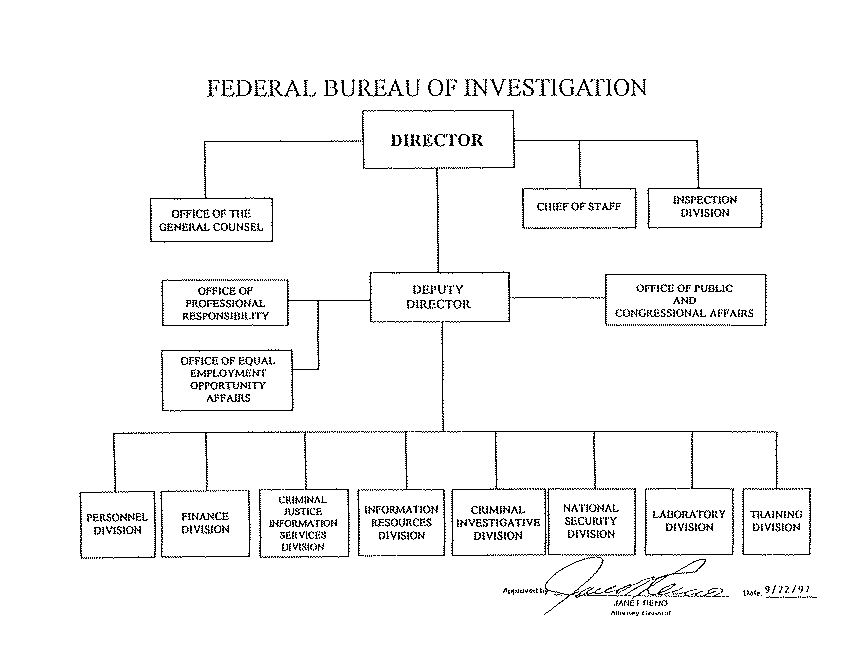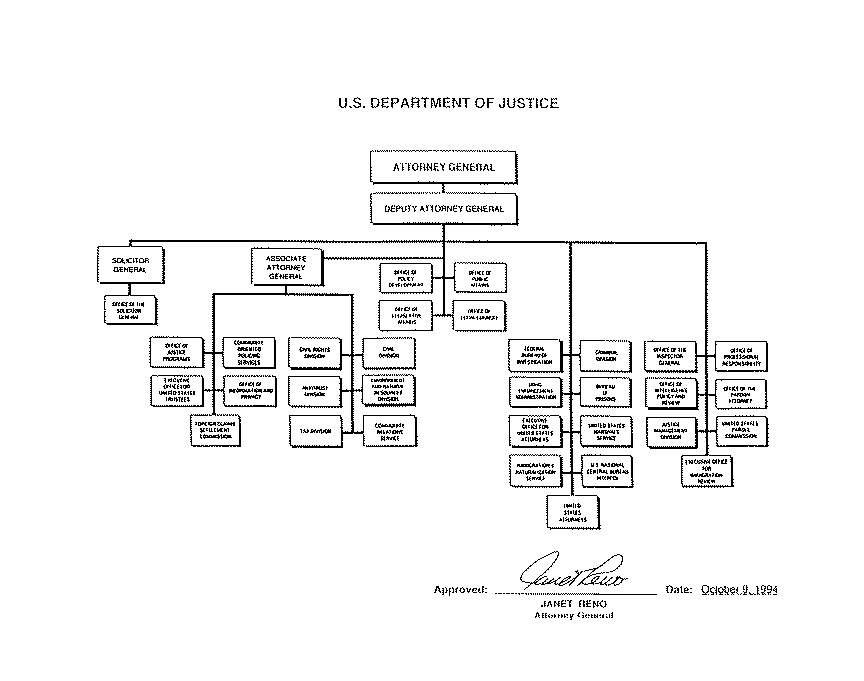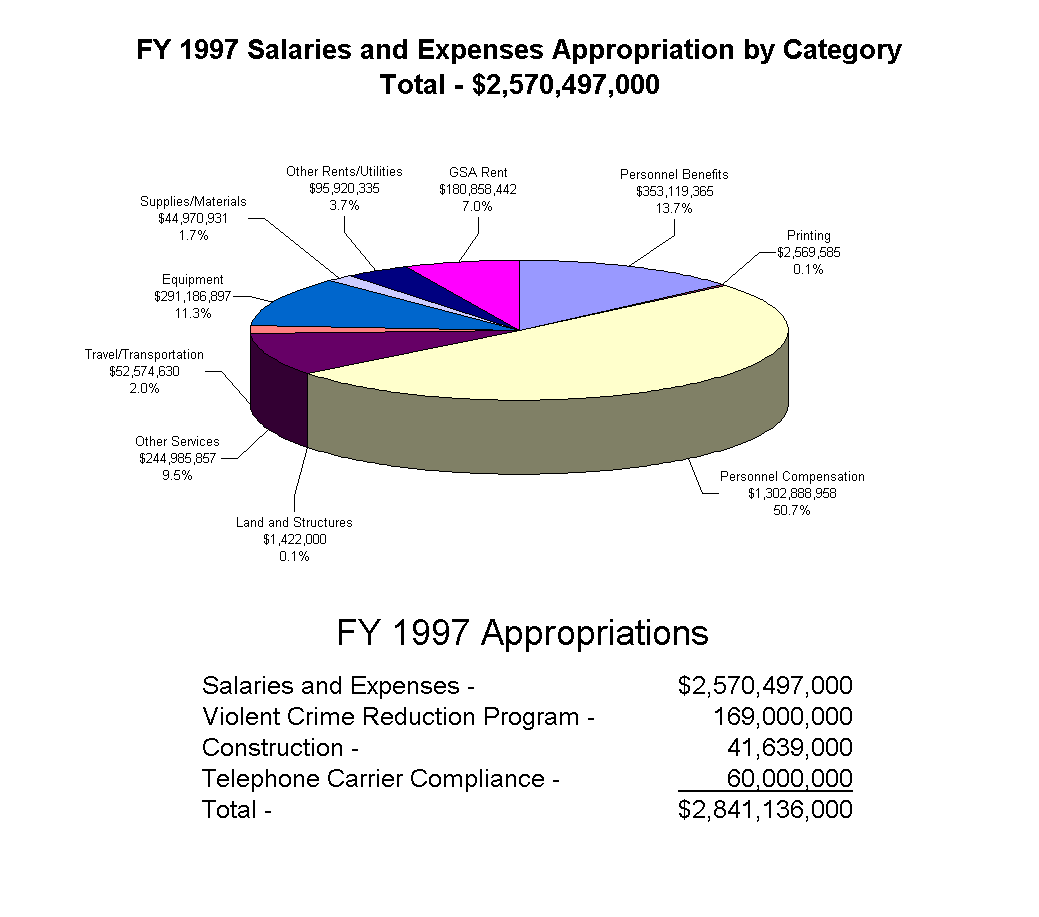

SUPPLEMENTAL FINANCIAL AND MANAGEMENT INFORMATION
Supplemental Information:



Performance Goals and Results
The FBI continued to aggressively implement the requirements of the GPRA by making significant changes and improvements to its annual budget submission and by organizationally aligning the strategic planning and budget functions under the Chief Financial Officer. These changes were all part of the FBI's long-term plan to develop a resource based, results oriented strategic management system. In implementing its plan, FBI efforts during FY 1997 were focused on developing strategic plans in the operational areas of the FBI and establishing performance measures that accurately captured the FBI's progress in meeting operational strategic goals.
While the FBI previously integrated the requirements of the GPRA into its annual budget submission so that it would serve as the FBI's annual performance plan, a new summary performance plan was developed and included in the FY 1999 budget submission. This summary plan highlights the most significant anticipated results expected for the fiscal year.
After assessing feedback from our respective oversight authorities, the FBI modified its budget submission to emphasize the planning and performance elements of the GPRA. Programmatic information included crime assessments, explicit linkage to the Department of Justice (DOJ) Strategic Plan, a full range of historical performance indicators including input, output and outcome measures, and a summary of issues and challenges facing the program. The issues and challenges essentially identify those external and internal factors that could impact performance and identify the performance gap - the difference between the extent of a particular crime problem and the degree to which existing FBI resources could realistically address this problem. The performance gap is now used to identify FBI funding needs for future budget requests.
Throughout the implementation of GPRA it became clear that the best performance measures were being developed in operational areas that had long-term strategic plans in place. It also became clear that performance measures in non-operational programs needed to reflect the degree to which the function is supporting the accomplishment of the operational mission of the FBI. Thus it became critical that the FBI develop an organizational strategic plan that aligned all organizational entities toward a set of common goals and program strategic plans that guide day-to-day operations. To that end, the FBI reengineered its organizational strategic planning process during FY 1997. The new process focuses the FBI's investigative and national security programs on results and establishes the operational strategic direction for the FBI. The strategic direction will form the basis for program and field strategic plans which will then serve as the basis for the FBI's annual budget submission. Thus the strategic plan will serve as a blueprint for meeting the agency's mission, budget requests will be formulated to meet the objectives identified in the plan, and both program and financial performance measurements will better gauge progress across all programs in meeting strategic milestones.
The FBI also continued to promote the broader implementation of GPRA through its liaison and coordination efforts with the DOJ, the Drug Enforcement Administration, and the Treasury Department. The FBI helped develop the DOJ's Strategic Plan and Annual Performance Plan, assisting with the creation of mutually agreed upon Department-wide goals, objectives and performance measures. The FBI also helped develop the Office of Management and Budget guidelines for the development of the annual performance plans and became a member of the Chief Financial Officers GPRA Budget Integration Subcommittee.
Performance Measurements:
La Cosa Nostra
| Type of Indicator | Performance Indicator | 1996 Target | 1996 Actual | 1997** Target | 1997 Actual | 1998** Target |
| Outputs | Number of Genovese and Gambino Family Members indicted and convicted | * | 27 | 47 | 29 | 50 |
| Number of Capos, consiglieres, underbosses, and bosses convicted and incarcerated | * | 36 | 40 | 34 | 40 | |
| Number of LCN members incarcerated | * | ***145 | 183 | 179 | 200 | |
| Outcomes | Percent reduction in LCN membership | * | 19% | 20% | 17% | 22% |
| Number of LCN influenced Union officials removed/barred through Civil RICO proceedings in: | ||||||
| HEIRU (Hotel Employees and Restaurant Employees International Union) | * | 11 | 15 | 6 | 10 | |
| Teamsters Union | * | 61 | 10 | 26 | 10 |
* The new performance measurement format was developed after the formulation of the FY
1996 budget request.
Therefore, FY 1996 target figures are not available.
** The performance measurement targets for FYs 1997 and 1998 are based on the most
accurate data as of 9/30/97.
*** The 1996 actual amount reflects an adjustment to the prior year number for actual
members incarcerated.
Eliminate the LCN as the most significant organized criminal enterprise.
Although weakened by recent FBI successes, La Cosa Nostra (LCN) remains the most pernicious and widespread crime problem facing the FBI. The FBI believes it is now in a position where a dedicated effort over the next five years could result in a total collapse of the entire enterprise. This effort calls for reducing the wealth and national influence of the country's two most powerful LCN families, reducing the membership of all LCN families by 25 percent, indicting and prosecuting their leaders, and depriving their organization of its financial basis. The FBI will remove the LCN affiliated individuals from organizations such as labor unions and contracting cartels which make up their base of power.
Long term indicators of success will include such things as the degree to which free competition has been restored in industries traditionally dominated by the LCN. Enhanced competition should result in reduced market prices for goods and services heretofore "taxed" by the LCN. The FBI will track selected market-place indicators as a measure of the impact of this effort.
Crimes Against Children (CAC)
| Type of Indicator | Performance Indicator | 1996 Target | 1996 Actual | 1997 Target | 1997 Actual | 1998 Target |
| Activities | Number of Investigative Matters | * | 2,861 | 3,350 | 3,367 | 3,450 |
| Number of Cases Opened | * | 1,434 | 1,650 | 1,655 | 1,725 | |
| Number of Multi-Agency /Multi-Disciplinary Teams Established | * | 5 | 5 | 5 | 5 | |
| Outputs | Informations and Indictments | * | 459 | 470 | 514 | 500 |
| Arrests and Locates | * | 417 | 450 | 446 | 475 | |
| Convictions & Pretrial Diversions | * | 345 | 375 | 448 | 400 | |
| Number of CAC Specialized Schools Provided | * | -- | 2 | 2 | 4 | |
| Outcomes | Percentage of FBI Child Abduction Cases in which FBI Notification is within 1 hour of the Local Police Being Notified | * | N/A | 25% | N/A | 40% |
| Percentage of Child Abduction Cases in which FBI Deployment is within 3 hours of notification | * | N/A | 25% | 100% | 100% | |
| Percentage Increase in Safe Return of Victimized Children | * | N/A | TBD | TBD | TBD | |
| Increase in Number of Subjects Identified and Prosecuted who Traffick in Child Pornography | * | N/A | 10% | 15% | 10% | |
| CAC Specialized Schools Provided | * | N/A | Yes | Yes | Yes | |
| Impact | More Effective Resolution of CAC Cases | * | N/A | N/A | N/A | TBD |
| Better Trained CAC Coordinators | * | N/A | N/A | N/A | TBD | |
| Reduction of Children Victimized | * | N/A | N/A | N/A | TBD |
*The new performance measurement format was developed after the formulation of the FY
1996 budget request. Therefore,
FY 1996 target figures are not available.
NA = Not available at this time. Statistics are being compiled.
Pursuant to specific statutory authority, the FBI conducts investigations of Crimes Against Children (CAC) in a variety of areas, to include, child abduction/kidnapping; interstate child prostitution; interstate/international travel to engage in an illegal sexual act with a minor; child pornography transported interstate and distributed electronically via computer through the internet and online services; physical and sexual child abuse on government lands and in Indian Country; national and international parental kidnapping; and the Child Support Recovery Act.
With the appointment of two CAC Coordinators in each of the FBI's 56 field offices, the FBI has demonstrated a commitment to properly address the CAC problem. In 1997, the newly appointed CAC Coordinators were trained at the FBI Academy on numerous CAC issues. These Coordinators will continue to receive additional training each year. This increase in training will improve the efforts of the CAC Coordinators and provide them the expertise and direction they need in addressing their work. Through training and experience, the Coordinators will be very familiar with the pertinent statutes, legal issues, investigative protocols, interagency resources and FBI specialized CAC resources. This training will increase the successful resolution of CAC cases. In successfully addressing CAC matters through better training and a coordinated effort, the number of suspects identified and prosecuted will increase, thus reducing the number of potential child victims.
Efforts have been undertaken to improve the FBI's record keeping system on CAC matters. For example, in 1997 the FBI created new classifications for child abductions and children who are sexually/physically abused on government reservations. This change will allow the FBI to identify relevant data on these types of cases, which could not be accomplished in the past. In 1998, the FBI plans to implement a new nationwide kidnapping database which will also assist the FBI in capturing relevant data.
Violent Street Gangs
| Type of Indicator | Performance Indicator | 1996 Target | 1996 Actual | 1997** Target | 1997 Actual | 1998** Target |
| Activities | Number of Investigative Matters | * | 1,662 | 1,625 | 1,827 | 1,725 |
| Number of Cases Opened | * | 653 | 450 | 659 | 675 | |
| Number of Racketeering Enterprise Investigations | * | 53 | 55 | 58 | 60 | |
| Number of Undercover Operations | * | 22 | 25 | 24 | 27 | |
| Outputs | Number of Gang Task Forces | * | N/A | 39 | 40 | 44 |
| Indictments and Informations | * | 1,652 | 1,700 | 1,804 | 1,720 | |
| Arrests and Locates | * | 2,639 | 2,800 | 2,709 | 2,880 | |
| Convictions and Pretrial Diversions | * | 1,601 | 1,550 | 1,405 | 1,600 | |
| Recoveries and Restitutions ($000) | * | $2,246 | $3,520 3,520 | $19,387 | $3,500 | |
| Value of Assets Received Through the Prosecution of Criminal Street Gangs | * | $3,504 | $3,900 | $3,900 | $4,100 | |
| Outcomes | Number of Events Resulting in Disruption or Dismantlement of Street Gangs | * | N/A | N/A | N/A | TBD |
| Percent Reduction of Violent Street Gang Crime in Targeted Locations | * | N/A | N/A | N/A | TBD | |
| Percent of FBI Field Offices showing Reduction in Violent Street Gang Crime | * | N/A | N/A | N/A | TBD | |
| Impact | Violent Crime Statistics | * | N/A | N/A | N/A | TBD |
| Perceptions of Community Safety | * | N/A | N/A | N/A | TBD |
*The new performance measurement format was developed after the formulation of the FY
1996 budget request. Therefore,
FY 1996 target figures are not available.
**The performance measurement targets for FYs 1997 and 1998 are based on the most accurate
data as of 9/30/97.
In 1993, the FBI established its National Gang Strategy. This national strategy incorporates the investigative and prosecutive theories of enterprise investigations which have proven to be successful in the Organized Crime/Drug Program National Strategy. Stated succinctly, the strategy is for the FBI, in conjunction with other Federal, State and local law enforcement agencies, to identify the major domestic violent street gang/drug enterprises which pose significant threats to the integrity of American society and pursue these gangs through the sustained, proactive, multi-divisional, coordinated investigations that support successful prosecution.
As of September 1997, the FBI had established 159 Safe Street Task Forces (SSTFs) in 55 field offices throughout the United States, including San Juan, Puerto Rico, and the United States Virgin Islands. The SSTFs have teamed together 777 FBI Agents, 1,186 State and local officers, and 180 other Federal law enforcement officers. There are 48 Violent Crime task forces, 33 Violent Crime/Fugitive task forces, 40 Violent Crime/Gang task forces, 23 Fugitive task forces and 15 Interstate Theft task forces. Based on feedback from State and local law enforcement officials, the SSTFs are extremely effective.
OFFICE OF THE INSPECTOR GENERAL, AUDIT DIVISION
ANALYSIS AND SUMMARY OF ACTIONS NECESSARY
TO CLOSE THE REPORT
FBI management was provided a draft of the Independent Auditors' Report on Internal Controls over Financial Reporting and their comments on the findings and recommendations were incorporated into the body of the report. Since management concurred with all of the recommendations, this report is being issued resolved. Additional corrective actions, described below, need to be completed by management in order for the OIG to close the report.
Recommendation Number:
1. Resolved. Please provide the OIG a courtesy copy of the formal petition to the Joint Financial Management Improvement Program (JFMIP) and the Federal Accounting Standards Advisory Board requesting an official interpretation relating to the reporting applicability of FBI evidence not subject to forfeiture. We also request that you provide copies of the correspondence received regarding this matter, at which time we will determine what action, if any, will be necessary to close this recommendation.
2. Resolved. In order to close this recommendation, please provide a copy of management's action plan for system enhancements that will be made to satisfy the JFMIP's core financial system requirements and ensure that subsidiary-level detail is available to support the general ledger's undelivered orders balance. A determination may be made through the FY 1998 Annual Financial Statement Audit process as to whether this recommendation will be closed.
3. Resolved. In order to close this recommendation, please provide documentation requiring monthly reconciliation procedures between general ledger control accounts and subsidiary systems.
4. Resolved. In order to close this recommendation, please provide a copy of revised procedures used to estimate accounts payable accruals at year-end. In the transmittal of this information, please identify the programs that were excluded and caused the understatement of FY 1997 accounts payable, and the new procedures that will ensure these amounts will be included in future accruals.
5. Closed. The status of this recommendation will be monitored in the FY 1997 OIG Report on the FBI Data Center.
6. Closed. The status of this recommendation will be monitored in the FY 1997 OIG Report on the FBI Data Center.
7. Closed. The status of this recommendation will be monitored in the FY 1997 OIG Report on the FBI Data Center.
8. Closed. The status of this recommendation will be monitored in the FY 1997 OIG Report on the FBI Data Center.
9. Closed. The status of this recommendation will be monitored in the FY 1997 OIG Report on the FBI Data Center.
#####